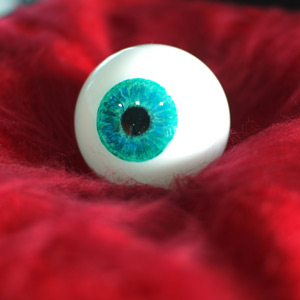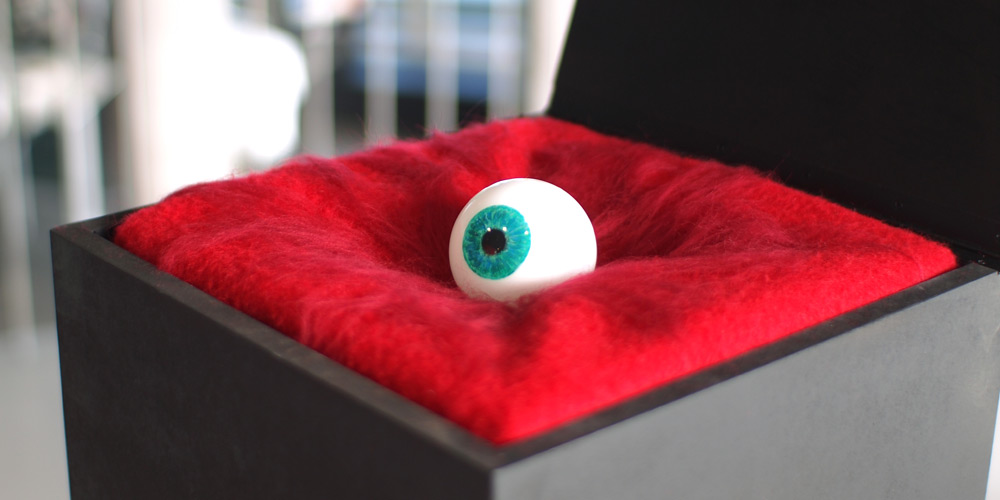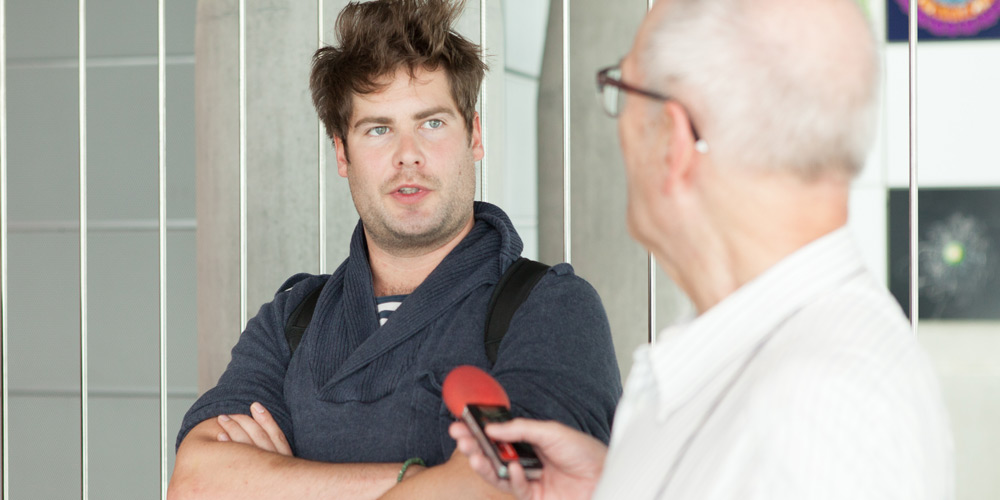The artificial eye looks relatively unassuming at first glance. The object created by the art student Julian Reil is gently nestled in a small black box. But if you look closer, you know why you suddenly get the feeling of being persecuted. Like an independent living creature it looks back to you – the exhibit and the visitor start to look at each other. The second episode of the exhibition series “TIME OUT .02” now shows the eye at the Ars Electronica Center in collaboration with the study “Time-based and Interactive Media” of Linz University of Art.
What’s “The Eye Named Frank” exactly?
Julian Reil: It is a square box with an edge length of about 30 centimeters and in this box, which is coated with velvet, one eye is positioned in the middle. Beneath the eye two servos are installed, which are placed in a Cartesian suspension to each other. So the axes intersect at the center of the eye. The movement of the servo results in a rolling movement of the eyeball. Inside the opened lid of the box there is a hidden camera system that recognizes faces through a webcam and a face tracking software that receives information about people in the room. The eye is programmed in the way that it follows the visitors in front of it in a 50-degree field of view. The eye is always looking at somebody. The prototype that I have built works fine, but when I found out that it is to become an exhibition object, I have decided to build an even more solid version. Also the eye itself, I have made new. Here I have chosen a wooden ball, because glass eyes are unfortunately too small, too expensive and too heavy, and even styrofoam or plastic versions failed the tests. The wooden ball is primed white, then everything is finely painted by myself and coated with gloss paint.
What kind of software do you use?
Julian Reil: My software is based on the programming language Processing and the OpenCV library, which is loaded with features for face detection, and all sorts of other detections of machine vision. In addition, I use the open-source platform Arduino that controls the servos.
And how did you come to the idea to create an artificial eye?
Julian Reil: The concept has simply occurred to me then, and I liked it from the beginning. At first I tried to build it using LEGO technology, and when I realized that it actually works, I went to the course director and presented him my work. Then the prototype was created. The uncanny thing is, if you have this thing for weeks in your living room at home and you forget to turn it off, you always think of being actually observed. And you tend to give it a name and talk to it. Like a digital pet, and people said to me that I should turn it off because they do not bear to be observed. Already at the LEGO technology prototypes, I have seen that the eye has developed to an independent living and an entity, where you believe to be observed.
How did the eye got its name? And why don’t you have two of them?
Julian Reil: Actually, it is a tribute to Sergeant Frank Drebin from the comedy “The Naked Gun”. At first it was planned only as a small project at the university and eventually it got the name Frank because he was at that time a cult figure among my friends. Why is it only one eye, has practical and aesthetic reasons. Two eyes would be much more difficult to build. And the fact that it is just one eye plays with this horror component and the alienation of the object. Here the concept of the minimal organism is included – which components does a living being need to be perceived as an entity? It is one of the necessary minimum functions. If something returns the look to you, then you already have a much larger feeling of entity than like the “Thing T. Thing”, as was the case in the TV series “The Addams Family”. It happens relatively fast if something reacts to a stimulus from the outside, which belongs to you. Also, I wanted to suggest a mix between fairy tale world and technology – after all, the wooden box is so covered with red velvet and the eye in the box looks like from a magic box.
Why does Frank follow us?
Julian Reil: Many people interact willingly when they see Frank at first. And they will interact to a certain degree with the artificial eye. This is also fun. Then it’s getting also a little scary and they look to it closely. One wonders, how does it work really? And finally, you do not know what happens to the data that are processed here. However, most people are satisfied with the entertainment value and do not ask further. But, to put it very bold to say: social networks use the same tactics. Someone is entertained, something is offered to you and you get features of interaction that are supposed to hide the fact that someone is in fact completely sold and quantized as a person.



